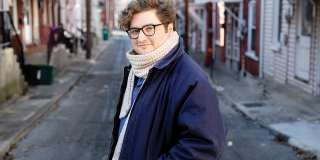
Recognizing that disciplines and research programs evolve during a faculty member’s career, the College of Arts and Sciences has awarded New Directions Fellowships for Mid-Career Faculty to three professors.
The awards, available to associate professors readying themselves for promotion, provide $10,000 a year for two years to support scholars who would like to pursue new directions in their research.
“The New Directions Fellowships continue to support exciting new research,” says Donald E. Hall, Herbert and Ann Siegel Dean. “The faculty selected this year will develop areas of scholarship that undoubtedly will expand the academic discussion and provide new perspectives in their particular disciplines.”
This year’s recipients are Kate Arrington, associate professor of psychology, Anna Chupa, associate professor of art, architecture and design (AAD), and Padraig (Pat) O’Seaghdha, associate professor psychology.
Arrington has studied cognitive control using a voluntary task switching paradigm she developed a decade ago. Support from the fellowship allows her to incorporate electroencephalographic (EEG) recording techniques into her research on cognitive control processes. EEGs record electrical activity generated by cortical neurons and the technique will allow Arrington to examine the brain’s activity at the time of a specific cognitive events. Expanding on previous research in cognitive control during multitasking, Arrington has identified specific EEG markers associated with task selection and task preparation, which she will be investigating as part of her fellowship. The fellowship also provides Arrington with support to attend specialized workshops for EEG analysis.
"The New Directions Fellowship will allow me to receive training in state-of-the-art neural recording techniques,” says Arrington. “Adding EEG to my research skill set will open up the exciting opportunity of examining cognitive processes in the millisecond time scale in which they unfold. I will be able to pull apart and precisely measure the task selection and preparation processes that support volitional action in multitask environments."
For Chupa, who is also associate chair of AAD, the fellowship allows her to expand on her previous design work. Her tiling designs are inspired by Islamic architecture from southern Spain, as she extracts photographs of plant details, montages them into still life compositions and embeds them into tiles. These tiles are arranged into patterns to create original textile designs which Chupa quilts using a longarm quilting machine. Her prior work also includes an extensive photographic study of New Orleans Vodun Temple altars. Chupa’s photography and textiles have been accepted into many national and international juried exhibitions, and support from a New Directions fellowship will allow her to expand her study of textile design. She will work on botanical drawings, which she will then “paint” with thread, sequins and a technique called couching. Couching gives a quilt texture by using a stitch that allows fibers to be added onto the surface of the quilt. It can be done by hand or machine, often with a zigzag stitch across the surface of the fiber to capture it and fasten it to the quilt. The result is a dense surface resembling embroidery. The fellowship supports Chupa’s efforts to develop original quilt pattern designs and expand her work outside of Islamic tiling patterns.
“Instead of the traditional pieced quilt, I create whole cloth quilts from my textile designs,” says Chupa. “The New Directions Fellowship gives me the opportunity to acquire Art and Stitch software, which enables me to convert vector drawings using my photographs as reference material into stitches. At that point, the stitching can be automated by the computer on the longarm machine. Up to this point I have been using hand-guided or freehand machine quilting. Now I can use the automated process with stitchery I have designed so that every step of the process from the fabric to the quilting is my design.”
O’Seaghdha, who has also served as director of Lehigh’s cognitive science program, specializes in the field of language production. He is interested in studying dynamic changes in the memorized mappings from thoughts to words as a function of contexts of use. These changes may employ a fundamental learning mechanism that strengthens the accessibility of recently selected words while at the same time down-regulating words that were simultaneously in mind but were left unspoken. This makes the unspoken words less available for subsequent use over significant time spans. The research includes behavioral experiments, an fMRI neuroscience component (conducted at Lehigh Valley Hospital in collaboration with Dr. Kevin Bannon and Lehigh professors Almut Hupbach and Dominic Packer, and computational work in collaboration with Hector Munoz-Avila, associate professor of computer science and engineering. The project links previously separate memory and language research domains, examines semantic re-mapping in a variety of contexts that draw on different components of meaning (e.g., simple object recognition, problem solving), and across languages in bilinguals, and will implement a large-scale simulation platform. It has previously been supported by a Faculty Collaborative Research (CORE) award.
“This fellowship comes at a great time in supporting the new semantic direction of my research,” says O’Seaghdha. “The coordination of knowledge and language in speaking is perhaps the most fundamental problem in my field, one that has been largely deferred because of its difficulty. But advances in science are bringing solutions within our reach. It is very exciting to study one facet of this problem through a fundamental learning process that runs unobtrusively in the background of our mental and linguistic lives, and that provides a window both on the substrates of meaning and on how meaning-to-word mappings are continuously updated as we engage with the world in various ways.”
- Robert Nichols






